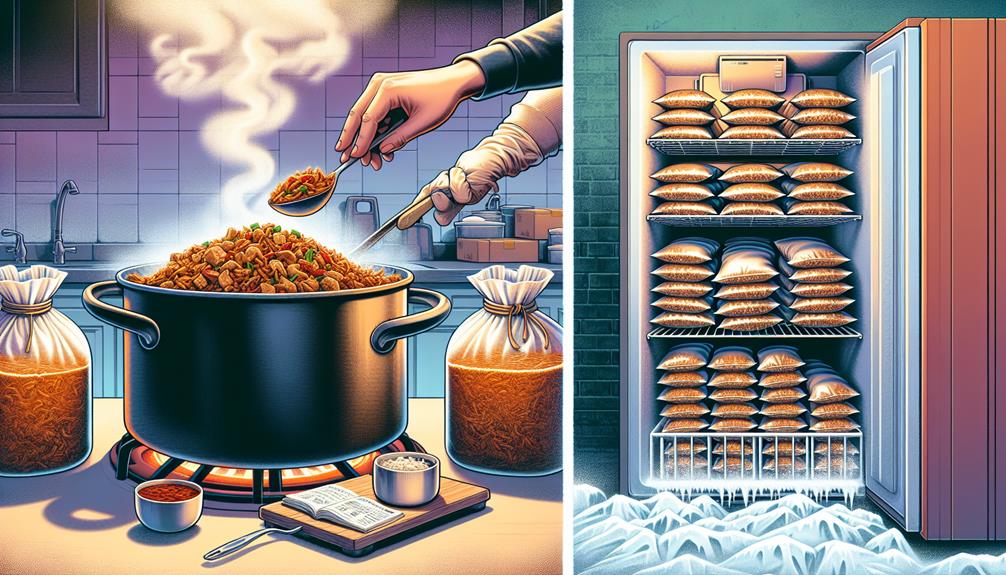They say a good meal can warm the soul, but when you've cooked up a pot of jambalaya that could feed an army, it's time to think about how to save some for later.
You've mastered the art of creating this flavorful, one-pot wonder, so let's ensure you can enjoy your hard work down the line without sacrificing taste or texture. Freezing jambalaya is a straightforward process, but you'll need to follow a few key steps to ensure it thaws out as delicious as it was the day you made it.
The trick lies in choosing the right containers, portioning wisely, and knowing the dos and don'ts of thawing and reheating.
Stick with me, and I'll unveil the secrets to locking in the vibrant flavors of your homemade jambalaya, so you can relish it on those days when cooking is the last thing on your mind.
Key Takeaways
- Gradually cool jambalaya to maintain texture and prevent rice from becoming mushy.
- Use fresh, high-quality meats and seafood and avoid overcooking before freezing.
- Portion jambalaya based on typical consumption to avoid thawing more than necessary.
- Add fresh herbs or hot sauce to revive flavors after thawing.
Preparing Jambalaya for Freezing
Before you stash your jambalaya in the freezer, make sure it's properly cooled to maintain its flavor and texture. Cooling it down gradually allows for the cooking consistency to remain intact, preventing the rice from becoming mushy and the proteins from drying out. To expedite the process, you might spread the jambalaya out on a baking sheet or divide it into smaller portions.
Ingredient selection also plays a pivotal role in how well your dish will freeze and reheat. Opt for fresh, high-quality meats and seafood, and don't overcook them before freezing. If you're using ingredients that don't freeze well, like shrimps or other delicate seafood, you might want to add these to the dish when you're reheating it, rather than before freezing.
Once your jambalaya is at room temperature, transfer it to airtight containers or heavy-duty freezer bags. Be sure to leave a little space at the top as the contents will expand when frozen. Properly stored, your jambalaya can last in the freezer for up to three months. Remember to label the containers with the date, so you'll know how long they've been stored.
Choosing the Right Containers
Having prepared and cooled your jambalaya, it's crucial to choose the right containers to ensure its longevity and quality in the freezer. When selecting containers for freezing, consider both container materials and seal effectiveness.
You'll want to opt for materials that are durable and freezer-safe, such as heavy-duty freezer bags or airtight plastic containers. Glass containers can also work if they're labeled as freezer-safe; just remember that they require more care to prevent breakage. The material should withstand cold temperatures without cracking or getting brittle.
Seal effectiveness is equally important. Your container's seal must be tight to keep air out and prevent freezer burn. If you're using freezer bags, squeeze out as much air as possible before sealing. With plastic or glass containers, ensure the lids fit snugly. Some containers come with a silicone seal or locking mechanism, which can provide an extra layer of protection.
Portioning and Packing Tips
When portioning your jambalaya for freezing, consider how much you or your family typically consume in one meal to avoid thawing more than necessary. Effective portioning is key to maximizing the convenience of your storage options and ensuring your serving sizes are ready to go when you are.
Here's a simple table to help you visualize portioning sizes:
| Portion Size | Serves | Ideal For |
|---|---|---|
| 1 cup | 1 | Single servings |
| 2 cups | 2 | Couples or small appetites |
| 4 cups | 4 | Family meals |
For single servings, pack 1 cup of jambalaya in small freezer bags or containers. This makes it easy to grab just what you need without defrosting a larger batch. When serving a couple or if you have a smaller appetite, 2 cups should suffice. Meanwhile, 4 cups are perfect for a family-sized meal.
Remember to label each container or bag with the date and contents. Squeeze out as much air as possible from freezer bags to prevent freezer burn. Use airtight containers if you prefer them over bags. By following these tips, you'll have your jambalaya ready in convenient serving sizes, ensuring a quick and easy mealtime.
Thawing and Reheating Methods
Once you've portioned and packed your jambalaya, it's time to focus on the best methods for thawing and reheating your meal to preserve its flavors and textures. Start by planning ahead; transfer your jambalaya from the freezer to the fridge at least 24 hours before you intend to eat. Proper refrigerator placement is crucial – put it on a shelf rather than in the door to ensure a stable temperature.
When you're ready to reheat, you've got a couple of options. If you're not in a hurry, you can warm your jambalaya in the oven. Preheat it to 350°F, transfer the thawed jambalaya into an oven-safe dish, cover with foil, and heat until it's piping hot throughout, which usually takes about 20 minutes.
For a quicker method, use microwave techniques. Place your thawed jambalaya in a microwave-safe dish, cover it with a lid or a microwave-safe cover, and use the reheat setting or 50% power to avoid overheating. Stir every couple of minutes to ensure even heating. This method will get your jambalaya hot and ready in a fraction of the time, typically 3-5 minutes depending on the portion size.
Maintaining Optimal Flavor
To maintain the robust flavors of your jambalaya after freezing, it's essential to handle the reheating process with care. Freezing can dull the spices and nuances of your ingredient selection, but with the right approach, you can revive your dish to its original gusto. Spice management is key; consider adding a fresh sprinkle of herbs or a dash of hot sauce to brighten the flavors after thawing.
Here are some pointers to ensure your jambalaya remains as tantalizing as the day you made it:
- Avoid excessive microwave reheating, which can unevenly heat and sap flavor. Instead, gently reheat on the stove.
- Freshen it up with a splash of stock or water to keep it moist and prevent drying out.
- Stir in some fresh herbs before serving to add a burst of flavor.
- Taste and adjust the seasoning, as freezing may mute the spices.
- Store your jambalaya in airtight containers to minimize freezer burn and flavor loss.

